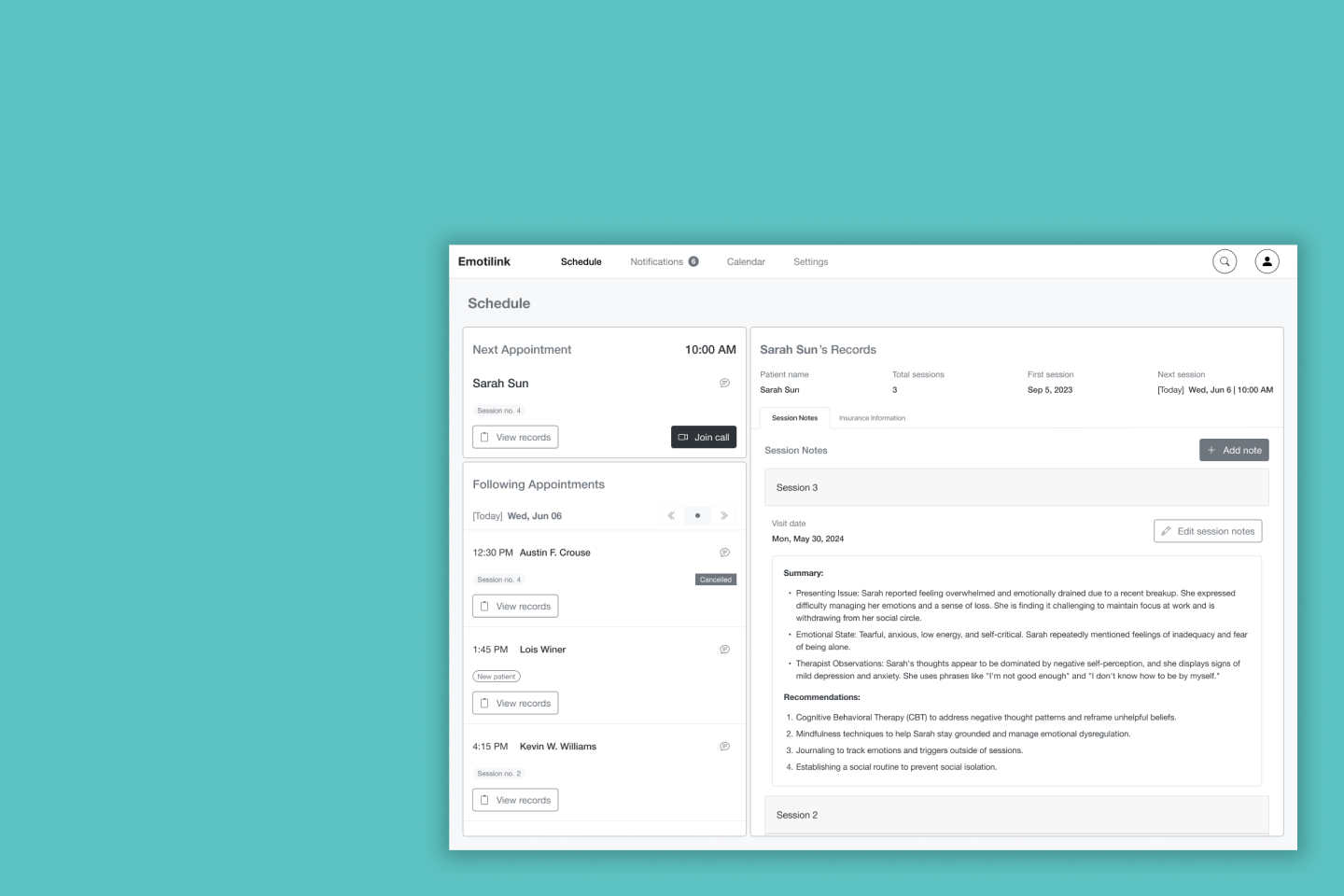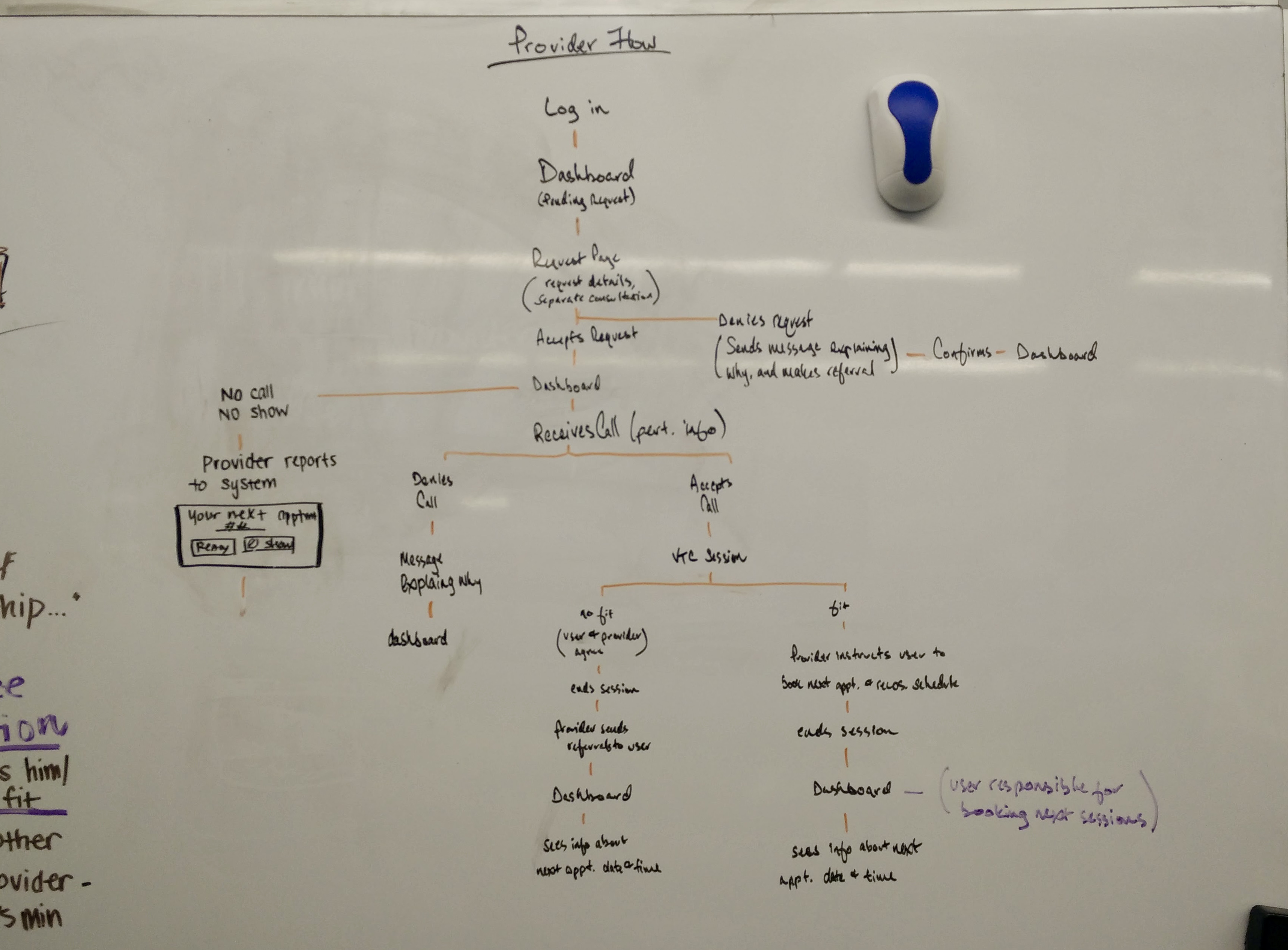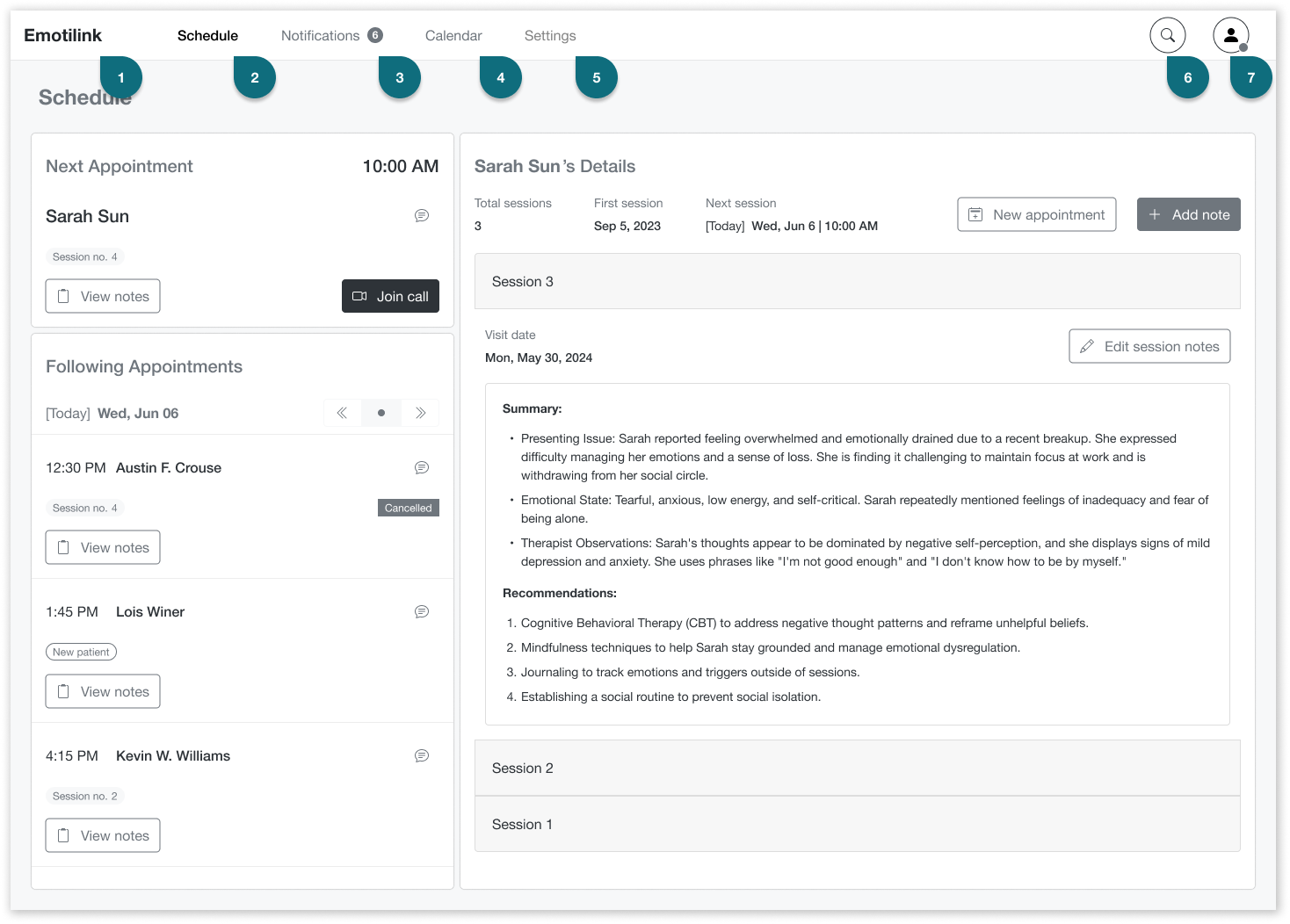The Brief
Emotilink, a groundbreaking healthcare technology startup in the MATTER healthcare incubator, aims to transform mental health support. Their pioneering mobile app and platform are designed to eliminate barriers to emotional support by providing real-time, HIPAA-compliant telemedicine encounters with mental health therapists. This innovative approach, which includes unique features such as [specific unique features], is poised to usher in a new era of mental health support.
The Emotilink team contacted my UX team and me for a consultation. Our task was identifying potential user concerns and opportunities and creating an initial design for their mobile and desktop applications. We conducted extensive user and domain research to inform our design process. Upon completing the project, we delivered low—to mid-fidelity interaction designs that provided a secure, focused, and seamless user experience for therapists and patients.
My role in the project was as a UX designer. My responsibilities included planning and conducting user interviews and surveys with my colleagues. We took turns moderating user interviews and taking notes. Afterward, we analyzed and synthesized the research results as a team and brainstormed design solutions. I took ownership of the competitive analysis because finding existing design patterns and opportunities to give my client an edge over their competitors was essential.
My main challenge as a designer was to create an experience where people feel safe and secure enough to open up to a therapist in a virtual setting. This required a high level of empathy and tact during conversations with participants. I needed to find a way to make a technology that could be used and seen as a tool for everyone to improve their mental health. I understood the task was sensitive and required considerable empathy and tact during conversations with participants.
Problem Statement
A lot of individuals go through emotional distress and need support but often struggle to access mental health services due to various barriers. These barriers can include not knowing about available resources, having trouble finding an in-person therapist, and feeling uncomfortable when choosing a therapist.
The Emotilink team also thought some people might be skeptical about developing a long-term therapeutic relationship through a mobile app.
“I think some people have problems going to a therapist because they don’t want to be that guy who goes to the therapist.”
– Emotilink Stakeholder
Emotilink aims to improve access to mental health support to empower individuals to prioritize their emotional well-being.
Our user research was comprehensive and thorough. We aimed to understand user needs, test our assumptions, and pinpoint design opportunities. We distributed a survey with open-ended questions, interviewed various user segments, and performed a competitive analysis to grasp the telehealth landscape for therapy. This extensive research provided a solid foundation for our design process.
Findings
We gathered enough data in two weeks to help our stakeholders answer their primary inquiries about our users, needs, and concerns.
Patients
-
Are people open to virtual therapy?
Yes, they are. Out of 38 respondents, 37 have used or considered using mental health services. From this group, ten were interested in using an app to connect with a mental health counselor, versus three who said no and the majority (20) who “would need to see the application in action to decide,” placing the burden for adoption on the user experience. -
Who will use the app?
People who need immediate improvement in their emotional well-being. These individuals have faced challenges and struggled to find someone to talk to due to scheduling conflicts or a lack of available providers. They need someone to help them navigate short-term issues when they arise. -
What offerings are critical for a virtual therapy application to work?
Flexibility
They want to be able to find someone when they need it.Reliability
They seek a tool to help them connect with a trustworthy, accessible, and relatable professional who shares a common identity and life experiences.User reviews
User reviews are significant when selecting a therapist for 66.7% of survey participants. 51.5% place more importance on user reviews than therapist recommendations.Privacy and confidentiality
The application must ensure session privacy and emphasize transparency, including how it moderates therapists' reviews.Payment
Knowing insurance options is complex and needs to be more transparent. 48.5% are unaware of their insurance plan’s mental health services reimbursement rates, and 39.4% believe they know them. Participants are willing to pay $10 to $120 out-of-pocket for a one-hour session if their insurance doesn’t cover it.
Therapist
-
Initial screening
Therapists want to determine if they are an appropriate fit for the patient. If not, they explain the situation to their patients and recommend another professional who could be a better fit. -
Transparency
Opening up to someone is a slow process. Therapists must communicate clearly and set expectations to establish trust and rapport quickly. They help users get in the right mindset. They expect the platform to be transparent with users’ expectations and aid with building long-term relationships. -
Trust
It’s challenging to determine a patient’s mindset and safety without reading body language and managing failed connections and dropped calls so patients do not feel ignored. -
Payment
It can be awkward to bring up payment during sessions, but billing medical insurance for virtual services and ensuring competitive rates are important aspects to consider.
Competitive Analysis
We meticulously studied five of Emotilink’s competitors (Amwell, Breakthrough, Doctor on Demand, Talkspace, and Teladoc) at the time (2016) and analyzed their features and offerings. This comprehensive analysis involved examining user interfaces, reading user reviews, and understanding their business models. It gave us a clear understanding of the market landscape and helped us identify areas where Emotilink could differentiate itself.
What we found about the 5 competitors...
5
Provided video sessions
4
Provided phone sessions
1
Provided Instant Messaging
2
Provided on-demand services
4
Took health insurance.
After gathering and analyzing our research findings, we embarked on the design process with a user-centric approach. We brainstormed solutions to each problem expressed by our users and did rough wireframing on features that address critical user needs. We then conducted two rounds of user testing and iteratively refined our design based on users’ feedback. We focused on the user's experience, ensuring the application's usability and effectiveness.
Our Solution
An application for desktop and mobile devices that connects patients with available therapists who work flexible schedules to help them with ongoing or immediate issues.
For therapists
“I would never schedule back-to-back sessions. My hand would get too tired. I wouldn’t do it for one session; I would have it sit on my laptop.”
– Interviewed Therapist
We designed a desktop application for Therapists, giving them enough space to manage their patients' information comfortably and efficiently. We ensured that patients’ personal and sensitive information was protected and gave users complete control over what they shared upfront to foster a sense of trust and confidence in the platform.
We recommended that therapists avoid dealing with insurance information and have personalized customer experience professionals handle the payment hassle. This would allow therapists to focus on their patients' emotional well-being.
2. Schedule
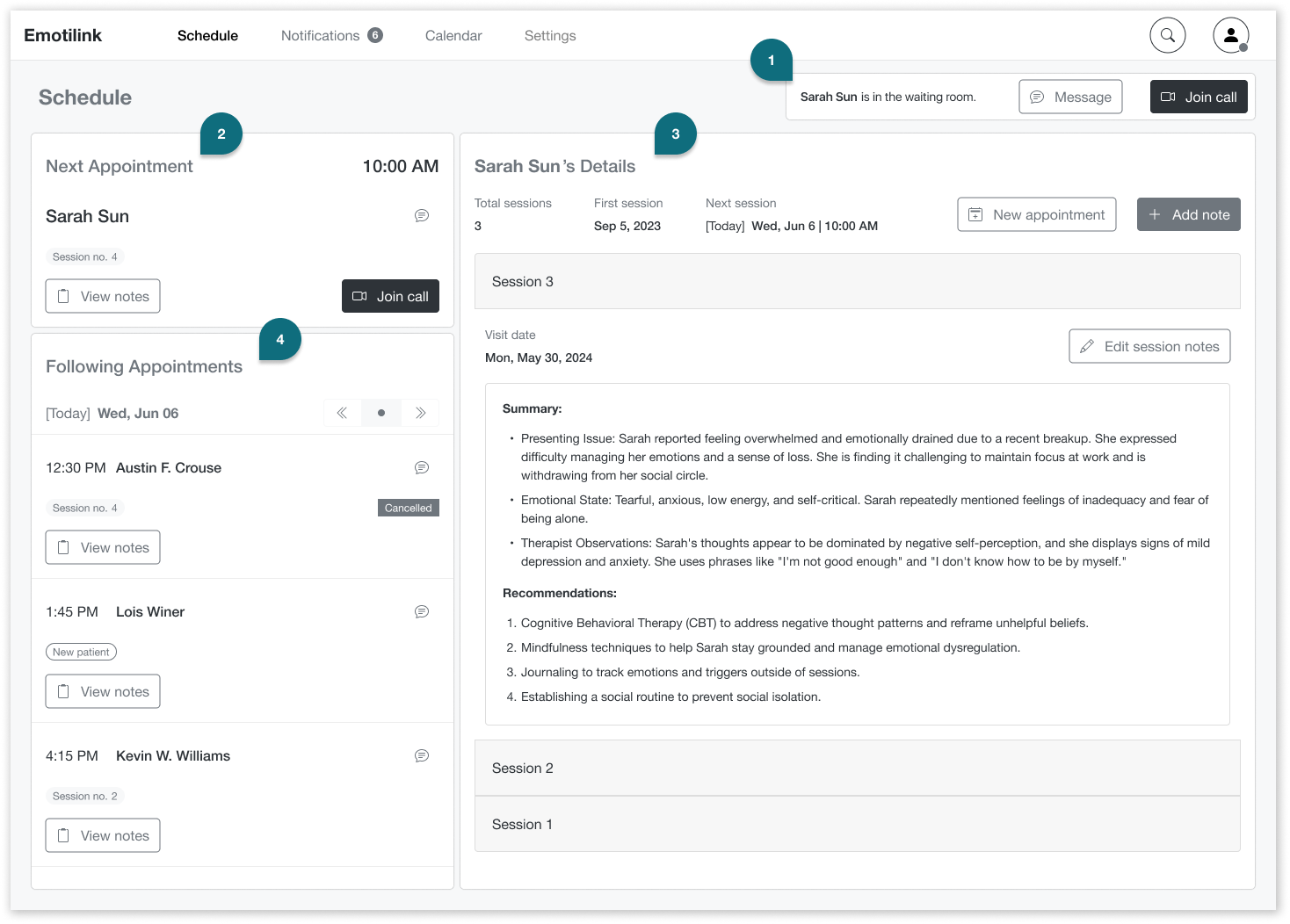
- Waiting Room alert
A Waiting Room notification alerts the therapist when a patient has joined the call and is ready for their session. The therapist can then enter the call or message the patient if something unexpected happens.
- Next Appointment
The Next Appointment section displays the next patient’s essential information and actions to help the therapist prepare and keep the patient in mind.
- Patient’s Details
In the Patient’s Details section, the therapist can view notes from previous sessions, add new ones, and schedule more appointments.
- Following Appointment
The Following Appointment section provides a quick overview of the upcoming sessions for the day, including essential information like the number of previous sessions and the scheduled time. It also includes a date selector for therapists to view their list of sessions for future days.
3. In Session
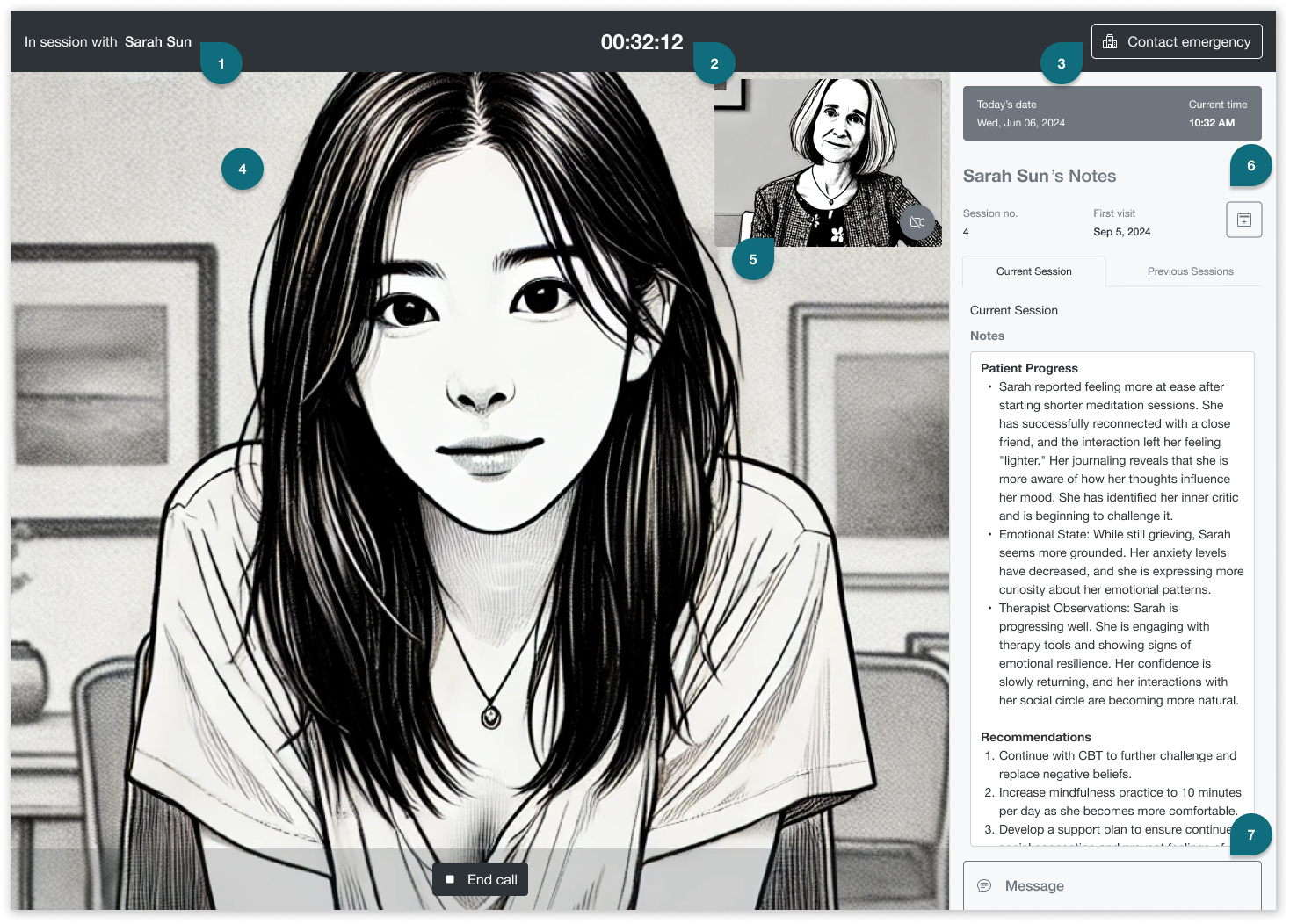
- In session with [patient_name]
Title to help keep therapist focused on her patient, her name, and identity.
- The current session timer
Indicates top-center the time the patient is in session with a therapist so they can manage their time effectively.
- Contact emergency [button]
In cases when the therapist determines that the user is a danger to themselves or others and needs to connect with the user's local mental health clinic or 911.
- Patient’s video
It will take up the screen’s view so that the therapist can read body language and connect with their patients. The End call [button] is necessary in case of technical problems or to protect the therapist if the patient displays inappropriate behavior or other concerns.
- Therapist's self-view video
Allows the therapists to view themselves from the user's perspective.
- Patient’s Notes
This session shows essential information such as the patient’s name, session history with the therapist, and today’s date and time. It includes adding notes for the current session and seeing notes from previous sessions.
- Message
The instant messaging functionality will help therapists share online resources or overcome verbal barriers with written language.
4. Notifications
For the therapist to manage appointment requests and confirmations.
4.1 Requests
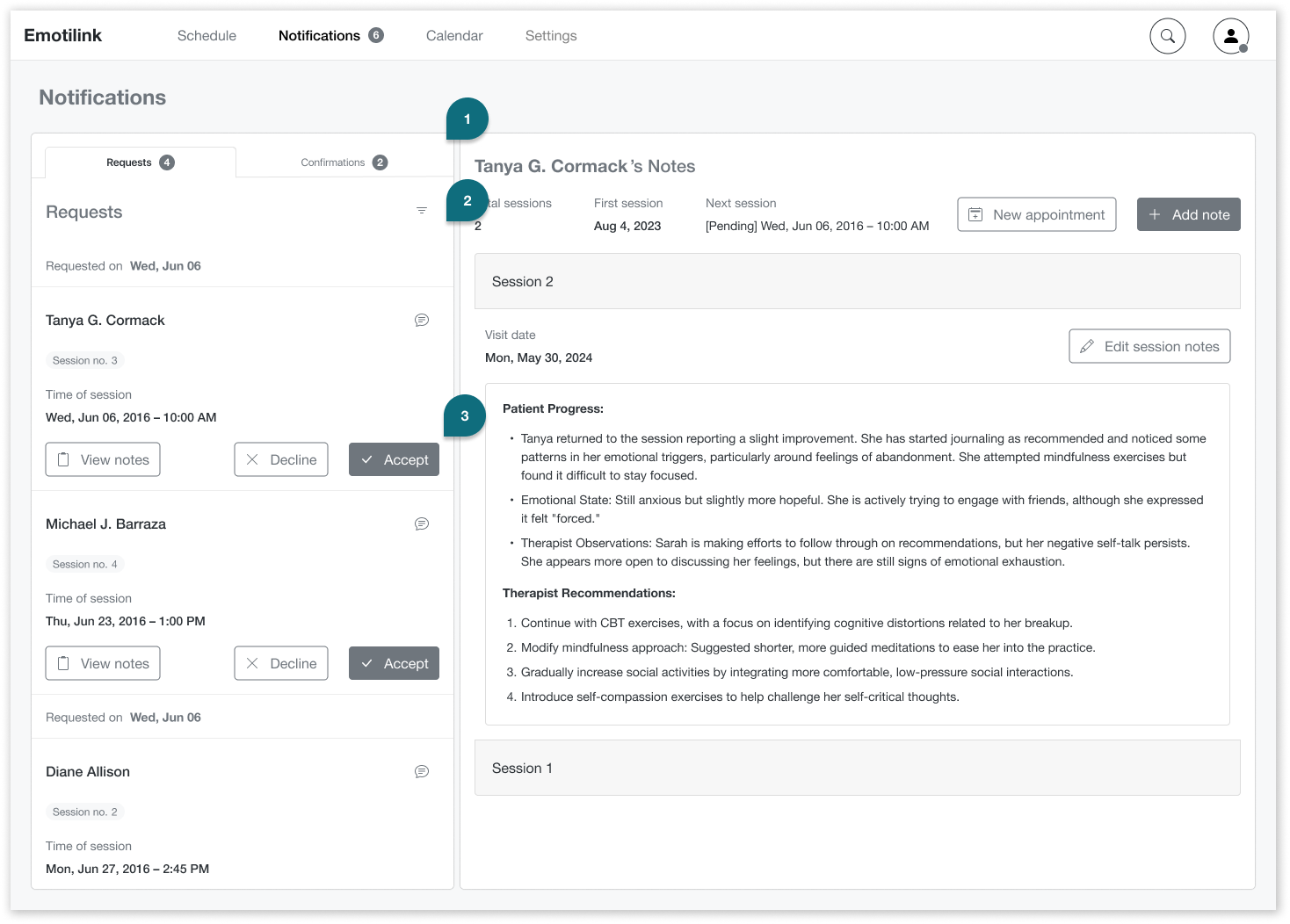
- Requests
A quick overview of session requests. Therapists can view general details, including the patient’s name, the requested session count, and the time of the session.
- Requests filter
To view requests by the date requested, patient’s name, time of the session, etc.
- Message, Decline, or Accept [buttons]
Therapists can message the patient to reschedule if needed. They can also view the patient’s records before accepting or declining. Option for therapists to choose who he will attend or who he will need to refer to another therapist if required.
4.2 Confirmations
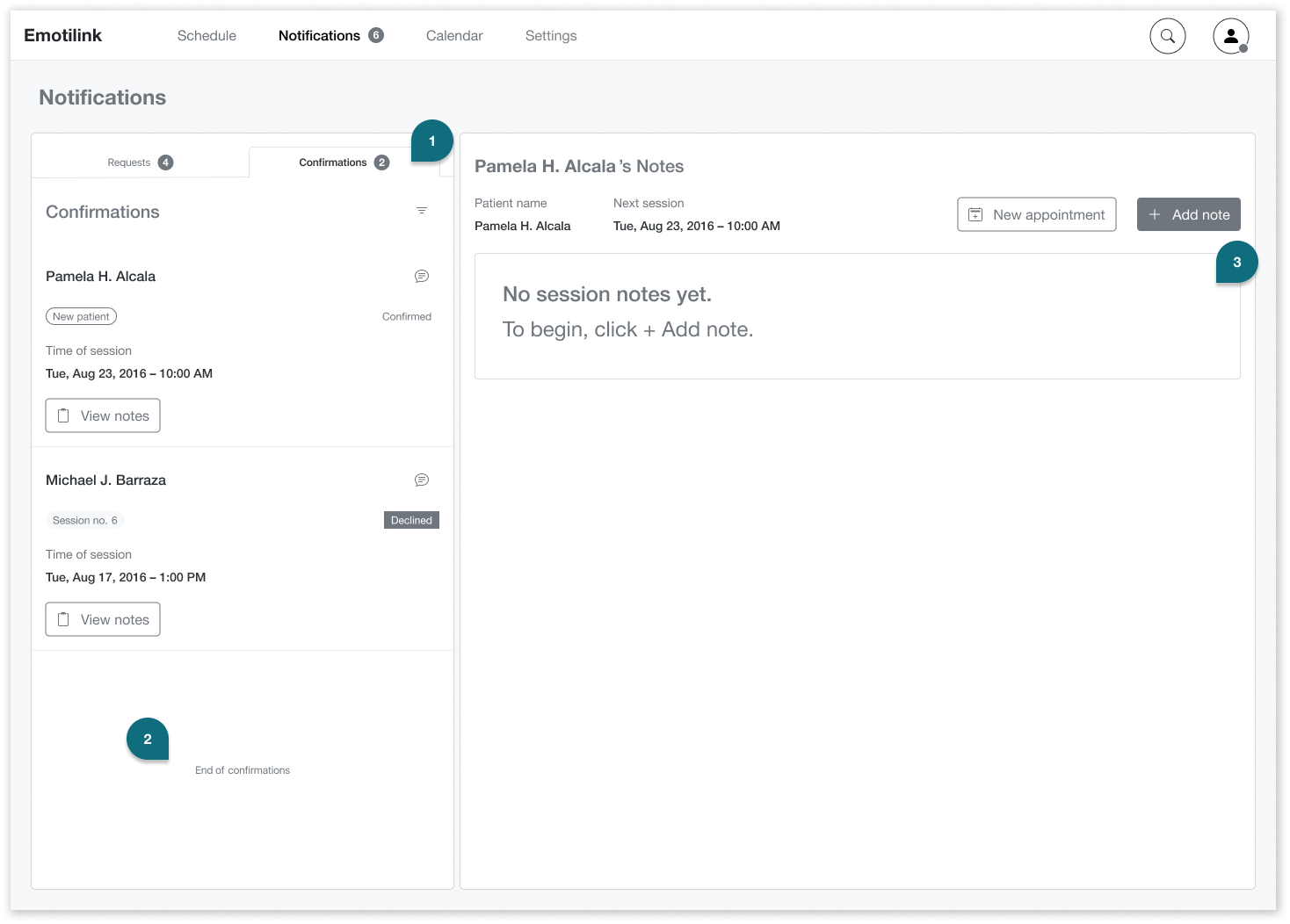
- Confirmations
In the Confirmations section, therapists can see who has confirmed or declined their appointments.
- End of list message
This will let the therapist know when he’s caught up with all notifications and scheduled appointments.
- Empty states
Empty states are informative, with clear instructions on how to begin to help therapists prepare their initial screening process ahead of the session.
Results
The project outcomes were discussed, including metrics and user feedback. The Emotilink team was satisfied with the result. The solutions we provided were aligned with the data gathered from users themselves. We recommended further user testing to ensure that the design satisfies user needs. We informed them that evaluation research will uncover potential issues with our designs before the technology makes it into production. Additionally, we plan to talk with engineers to review the feasibility of our recommendations so that the business can adjust to budget considerations by prioritizing and downscaling as needed.
Reflection
Everyone benefits from talking with a therapist, including the therapist. Technology has been pivotal in improving humanity’s livelihood and longevity, but strides are still being made to help people’s emotional well-being. It was great to be part of this landmark effort and to use my design skills to play a small part in making mental and emotional health accessible to more people using current technology.
